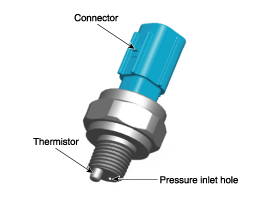Hyundai Genesis: Engine Control System / CVVT Oil Temperature Sensor (OTS) Description and Operation
Hyundai Genesis (DH) 2013-2016 Service Manual / Engine Control / Fuel System / Engine Control System / CVVT Oil Temperature Sensor (OTS) Description and Operation
| Description |
Continuous Variable Valve Timing (CVVT) system advances or
retards the valve timing of the intake and exhaust valve in accordance
with the ECM control signal which is calculated by the engine speed and
load.
By controlling CVVT, the valve over-lap or under-lap occurs,
which makes better fuel economy and reduces exhaust gases (NOx, HC) and
improves engine performance through reduction of pumping loss, internal
EGR effect, improvement of combustion stability, improvement of
volumetric efficiency, and increase of expansion work.
This system consists of
- the CVVT Oil Control Valve (OCV) which supplies the engine
oil to the cam phaser or cuts the engine oil from the cam phaser in
accordance with the ECM PWM (Pulse With Modulation) control signal,
- the CVVT Oil Temperature Sensor (OTS) which measures the engine oil temperature,
- and the Cam Phaser which varies the cam phase by using the hydraulic force of the engine oil.
The engine oil which is supplied through the CVVT oil control
valve varies the cam phase in the direction (Intake Advance/Exhaust
Retard) or opposite direction (Intake Retard/Exhaust Advance) of the
engine rotation by rotating the rotor connected with the camshaft inside
the cam phaser.

 Rail Pressure Sensor (RPS) Repair procedures
Rail Pressure Sensor (RPS) Repair procedures
Inspection
1.
Connect the GDS on the Data Link Connector (DLC).
2.
Measure the output voltage of the RPS at idle and various engine speed.
ConditionOutput Voltage (V)Idle Approx. 1.21, ...
 CVVT Oil Temperature Sensor (OTS) Specifications
CVVT Oil Temperature Sensor (OTS) Specifications
Specification
TemperatureResistance (k?)°C°F-40-4041.74 ~ 54.54-20-414.13 ~ 16.830325.28 ~ 6.325771.88 ~ 2.14801760.31 ~ 0.331402840.07 ~ 0.08
...
Other information:
Hyundai Genesis (DH) 2013-2016 Owners Manual: Releasing the parking brake
To release the EPB (Electric Parking Brake), press the EPB switch in the following condition: Place the Engine Start/Stop button in the ON position. Depress the brake pedal. Make sure the Parking Brake Warning Light goes off. To release EPB (Electric Parking Brake) automatical ...
Hyundai Genesis (DH) 2013-2016 Service Manual: Rear Axle Flange Repair procedures
Removal Use caution when handling the transfer case. Preventing the ITA (Integrated Transfer case Actuator) from damage 1) In case of transporting the transfer case • Use caution when lifting the transfer case from the transporting package to make sure the ITA doe ...
© 2013-2025 www.hgenesisdh.com
